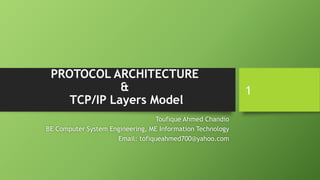
Protocol architecture TCP IP
- 1. PROTOCOL ARCHITECTURE & TCP/IP Layers Model Toufique Ahmed Chandio BE Computer System Engineering, ME Information Technology Email: tofiqueahmed700@yahoo.com 1
- 2. Agenda / Topics • The Need of Protocol and Architecture • TCP/IP Protocol Architecture • TCP Layers • How TCP/IP Works on internet 2
- 3. Need of Protocols When two or more devices connect in such a way that they can share any type of data like files, folders. So for that, they must have some time of connection between both devices. There must be a path between both computer either directly or may be via any type of network. For that few things must be there to make successful exchange of data: Both computer must be active and able to share data. Both has the same configuration of communication If PC one send some data, destination must to active to receive data or vice versa The file must be in such format that destination will able to receive it and work on it as per requirement. It is very much clear from all statements for a successful exchange of data, every PC must follow all above steps. Rather we will implement all this logically on each device. The task is broken into subtask, each will implement separately. 3
- 4. Need of Protocols In protocol model, Modules(Subtask) arrange in vertical order and each layer module perform separately with the coordination with other layers. Of course for this purpose, both machines has same layers architecture to perform successful exchange of data. The transfer of data is achieved by having peer(corresponding) layers into a system. These layers communicate with a formatted of blocks of data that obey some kind of set of rules, known as “Protocols”. The main features of Protocol will be in next slide. 4
- 5. Key Features of Protocol • Syntax: Concerns the format of the data blocks • Semantics: Includes control information for coordination and error handling • Timing: Includes speed matching and sequencing In the result after the research and successful experiments of packet switching by APRANET, TCP/IP was introduced. 5
- 6. Introduction about TCP/IP TCP IP was introduced after the successful experiments of ARPA APRANET, funded by US, TCP IP has a collection of protocols that has been introduced by IAB (Internet Activities Board). In simple, TCP IP consist of three basic components: 1: Application 2: Computers 3: Network 6
- 7. TCP IP Layers Keep in mind the concept of data exchange from one computer to another. For this, TCP IP has 5 layers architecture as below given: 1: Physical Layer 2: Network Access Layer 3: Internet Layer 4: Host-to-Host or Transport Layer 5: Application Layer 7
- 8. Physical Layer This Layer deals with physical connection between devices. It is mainly deals with data transmission and medium by which data transmits. It is usually concerned with specifying characteristics of transmission medium, nature of signals, data rate and related matters. 8
- 9. Network Access Layer The network access layer is concerned with the exchange of data between an end system (server, workstation, etc.) and the network to which it is attached. The computer that sends data must provide address with network of destination so that network routes data to appropriate destination. The specific software used at this layer depends on the type of network to be used; different standards have been developed for circuit switching, packet switching (e.g., frame relay), LANs (e.g., Ethernet), and others. The network access layer is concerned with access to and routing data across a network for two end systems attached to the same network. 9
- 10. Internet Layer When devices are connected with different networks , some procedures are applied for successful data transmission. Data travel through multiple interconnections networks, this procedure is known as Internet Layer. The Internet Protocol IP is used for this purpose to send data over different routers by multiple networks. A router is a processor that connects two networks and whose primary function is to relay data from one network to the other on its route from the source to the destination end system. 10
- 11. Host-to-Host or Transport Layer It is necessary to ensure that the data receive at destination must be in same pattern as it were send from source. Keeping that view, to make sure the mechanisms for providing reliability are essentially independent of the nature of the applications. Thus, it makes sense to collect those mechanisms in a common layer shared by all applications; this is referred to as the host-to-host layer, or transport layer. The Transmission Control Protocol (TCP) is the most commonly used protocol to provide this functionality. 11
- 12. Application Layer The application layer contains the logic needed to support the various user applications. For each different type of application, such as file transfer, a separate module is needed that is peculiar to that application 12
- 13. How TCP/IP Works 13
Notes de l'éditeur
- 1